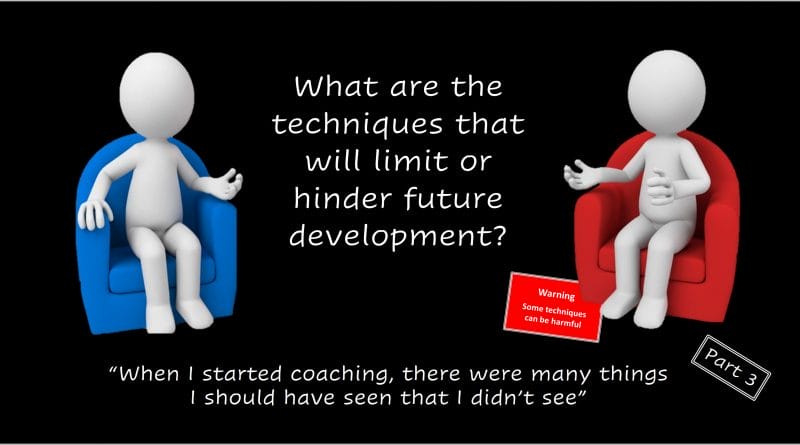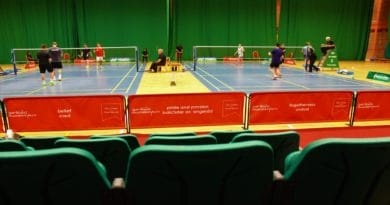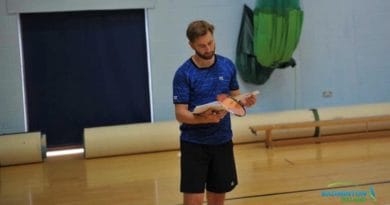Error prevention rather than error correction : Part 3
The easiest way to play badminton often results in techniques that can severely limit future development
Self-discovery techniques often don’t provide the best outcomes if future performance is a goal
Some issues are easy to see, others not so. Come and explore them with me 🙂
What do you see with players who discover their own techniques?
Are you happy with the results?
– – – – – – – – – – – – – – – – – –
The mini-series considers if it’s possible to
- identify future limiting badminton techniques
- consider the impact of each one
- establish how they occurred and where to start to effect a change
- consider if ‘prevention’ is possible and the coaching methodologies to use
– – – – – – – – – – – – – – – – – –
What do you see & how do you react
Making sense of what you see
Recognition difficulties
Assessing the impact
My list
What next – how to examine these issues
– – – – – – – – – – – – – – – –
1. What do you see & how do you react
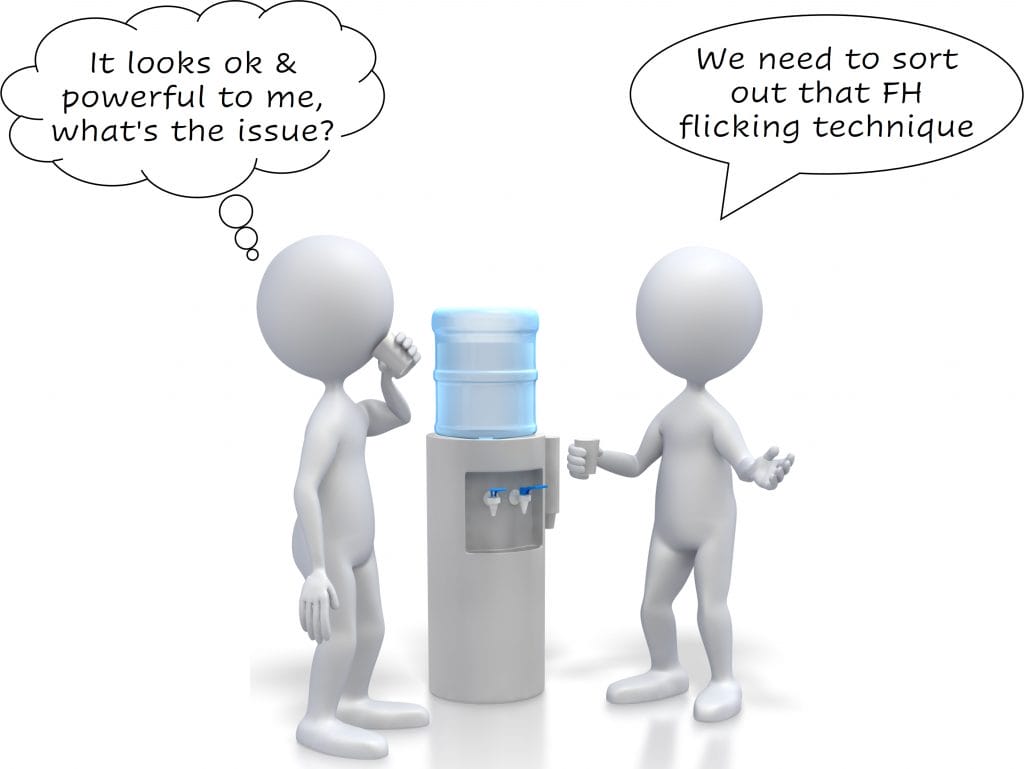 Seeing (observing) and recognising the critically limiting badminton techniques are 2 different aspects.
Seeing (observing) and recognising the critically limiting badminton techniques are 2 different aspects.
You may think that every coach sees the same thing as you and then comes to the same conclusion. This is not the case!
It’s tough to know exactly what every other coach sees because we all look with different viewpoints based on our knowledge of what is a technical fault. Maybe you don’t recognise the technique as an issue or you don’t know where to start a subtle change, a refinement.
Here are 4 reasons why coaches may struggle to act effectively after observing……
- Seeing something that you don’t recognise (you don’t know what you see)
- Embarrassed at what you see
- Seeing but not acting (deliberately doing nothing)
- Seeing and acting on everything immediately
- Seeing, understanding the importance and creating a plan … jump to No.2
Seeing something that you don’t recognise
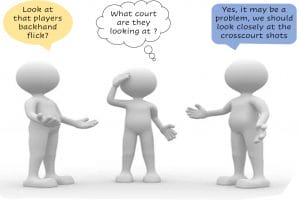 The issue of experience or lack of experience will always be there. Did you recognise yourself in the story about the 3 coaches in Part 2.4 of this min-series?
The issue of experience or lack of experience will always be there. Did you recognise yourself in the story about the 3 coaches in Part 2.4 of this min-series?
When you first start on the coaching journey there is so much to see when watching someone perform, you will find it difficult to sort and understand all the observations that you make.
Like me, you may find that you can’t decide what to look at, or what is the cause of something not working as you expected. That’s the reality of watching someone develop.
My advice is to make some observations, work out what you expect the outcome to be and what actually happened. Look at the technique preparation, the moving parts and then the finish (the recovery). This applies to the racket and the body.
Then ask another coach for their thoughts. However, don’t just assume that they can see more than you or that they have the same opinions as you. How you talk with other coaches is a skill in itself. Remember, not everyone likes questions 🙂
Embarrassed at what you see
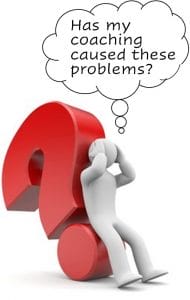 Yes, it’s true. Some coaches are embarrassed that their players would have badminton techniques that don’t seem effective.
Yes, it’s true. Some coaches are embarrassed that their players would have badminton techniques that don’t seem effective.
If you feel embarrassed or conscious that you have allowed or possibly created technique problems, my advice is to “forget your own feelings”. It’s time to act not, feel this way!
It’s difficult to know if issues develop because of coaching, the practices set or if it’s just something that happens to some players. In Part 1.4, I described the different possibilities for a technical issue to appear, and there may be more than the two suggested.
If you don’t review how you coach and make changes, then your players will probably not change either. Worse still they may leave your group to join another or start asking why they can’t perform as well as they like.
If you feel embarrassed that another coach is pointing out critical technique errors in your players then ask them for more advice and help. It’s not the time to let your embarrassment become a ‘wall’ around you.
Seeing but not acting
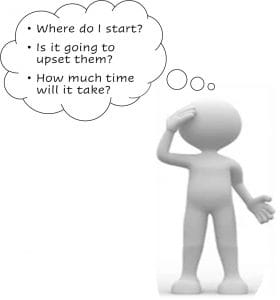 This may sound strange to you and not something you’d expect from a coach.
This may sound strange to you and not something you’d expect from a coach.
Why would a coach see something but not act on it! This does happen and for different reasons, all of which only the coach would know.
It could be that the coach feels that the effort and workload required to effect a positive change to an inappropriate technique (even if only partly established) is too great.
The player may be part of a larger group and the coach cannot allocate time, they believe is required. Or, the coach may decide that the struggle (and possible frustration) the player will experience is not something that they wish to experience.
In these situations, whatever the reason, the coach sees the limiting technical issue and decides to not try to effect a change in the technique.
How do you feel about this scenario? Can you think of other reasons why the coach may not try to change the technique?
Seeing and acting immediately (without a plan)
 This may sound like the most effective thing to do, to act immediately once you see the issue. The coach needs to act otherwise they aren’t coaching! 🙂
This may sound like the most effective thing to do, to act immediately once you see the issue. The coach needs to act otherwise they aren’t coaching! 🙂
However, the desire to effect a change immediately must be done with a plan. To act otherwise could lead to problems.
Coaches who immediately draw the players’ attention to the problem or offer verbal instructions are at risk of
- demotivating players
- causing unnecessary internal focus on a current technique
- making subtle changes much more difficult
Are you observing your players with an intention of gathering information
or are you merely just watching them, or worse still looking without seeing!
– – – – – – – – – – – – – – – –
2. Making sense of what you see
There is no one question to ask yourself when looking at a player’s technique.
I recommend that you use the series below and maybe put pen to paper to capture your thoughts. Reading them back later often provides new insights.
Although sometimes questions may not initially help you, it could be your feelings that guide you, more about that later.
Coaches should ask themselves the following questions: –
- What do I see? – can I recognise and name it?
- What was the intended outcome? – this applies to strokes and movements
- Was this achieved? – it doesn’t have to be a perfect outcome so you will have to use your judgement
- How does what I see compare with the known model? (the playing basics) – do you have the knowledge to list the essential elements of the aspect you are considering
- Where do I start to effect a change? – there is no need to answer this immediately, gather your thoughts first
Consider what outcome you expected and then what actually happened
Look at the technique : the preparation, the moving parts and then the finish (the recovery)
– – – – – – – – – – – – – – – –
3. Recognition difficulty – how easy is it to identify something that is technically inappropriate?
 I know from experience that it’s tough to do this when you first start coaching.
I know from experience that it’s tough to do this when you first start coaching.
You certainly see some things that don’t look right but often they are the ‘bigger’ technical issues. Those where players prepare in a different or strange way to what you expect. Those body or racket preparations taken up early are easier to see than something that happens in the middle of a ‘power stroke’.
I certainly struggled with the small, subtle issues that often happened within these power strokes and fast movements. I quickly realised that not everything was easy to see!
Soon I did realise that there was no link between how easy or difficult it was to see the ‘fault’ and the severity of it on future development.
But for me, it was one step at a time. The first step was to recognise something and be able to name it!
As you gain more experience and interact with other coaches your ability to see the technical issues will improve but only if you work at it. If you have a feeling that something isn’t right and looks different to what you see with other players then ask someone or have a discussion. Working together is always the best way to develop, but you must be open-minded and willing to ask questions or feel challenged.
When I started coaching, many things I should have seen I didn’t see
Technical issues were right in front of me but I didn’t have the experience until someone helped
Who is helping you, or who are you helping?
– – – – – – – – – – – – – – – –
4. Assessing the impact – knowing how technically limiting it is?
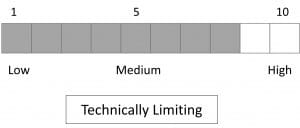 Identifying it is one thing, but just because it doesn’t fit your technical model or it looks strange doesn’t explain how impactful it could be to future development.
Identifying it is one thing, but just because it doesn’t fit your technical model or it looks strange doesn’t explain how impactful it could be to future development.
I’ve found (after being told) that some badminton techniques are far more impactful than others in terms of limiting future development. This also applies to the potential to cause injury.
When you first observe a badminton technique issue you may believe that it’s just part of players’ development, and that could be correct.
This is the toughest part of the process for coaches: deciding/knowing when to intervene and how much individual variance is acceptable. Of course not all player techniques will look the same, but some variations will (I promise) limit future development.
In the next series of posts I’ll suggest how difficult recognition is and give an indication of the impact severity of some classic issues
– – – – – – – – – – – – – – – –
5. My list
If player development and performance is your goal as a coach you need to know what badminton techniques issues may exist and be able to give them names.
To my knowledge very few if any Coach Education courses prepare coaches for this identification and assessment process.
Often identifying technique issues is easiest with novice players. If you’ve watched people first experience playing badminton you’ve seen the methods (the techniques) that they use to strike the shuttle. There is a logic behind most of what they do, unfortunately, this type of play often prevents or limits future development of power, variation, and may even cause injury.
You do not need to act (there are reasons why you may decide not to)
But you do need to know what the impact is of non-action
This is my list
Please take a look and tell me how many you see in novice players.
Do you recognise the names and do you agree that they require prevention if possible?
As you consider each one, I wonder what pictures you will create in your mind and if you will pick up a racket to move as if to replicate (or think about) the stroke or movement.
Not all of the badminton techniques listed are as critical as each other, this will vary. Also, it’s not my aim to prevent every single technical issue from developing, that would be fantastic but completely unrealistic.
When you read the list, if you have some views why not send me an email, contact@badmintonandy.com
My aim is to draw a coach’s attention to observations they may have and provide some explanation and ideas as how to progress
Summary
Grip, Overhead forehand hitting action, Overhead body action, Movement, Lunging, Backhands, Underarm lifts
Grip
- pan-handle – holding the racket so all the strings face towards the opponent very early in preparation for an overhead
- shortened – holding the racket near to the top of the handle at the junction of the shaft & handle
- finger up the shaft – where a finger is placed pointing up the handle
Overhead forehand hitting action
- bent arm – striking the shuttle around head (eye) height
- back-scratching – irrespective of the next stroke the racket is prepared so the head is almost touching the back of the body
- punch action – racket arm does not move in a ‘throwing’ like action
Overhead body action
- square-on – the upper body faces the net during early preparation for an overhead
- front foot hitting – stepping forward onto the non-racket leg in preparation for an overhead prior to striking
- low non-racket arm – the non-racket arm hangs down by the side of the player in preparation and during overhead striking
- lack of rotation – the body remains in a sideways position after striking with no turning of the shoulders
Movement
- Starting – limited or no use of loading of the legs (Split-step, Pretension)
- Stances – limited and inadequate use of preparatory stances
Lunging
- falling forward – overstepping onto the non-racket leg as recovery
- stopping position – sideways turning of the front foot when moving powerfully
- wrong leg – lunging onto the none racket leg just prior to contact when moving forwards
- bum high – tipping forwards and downwards when lunging resulting in the rear leg being off the ground
Backhands
- floppy wrist – presenting the back of the racket hand prior to and during contact
- elbow pointing – elbow high during the preparation prior to starting overhead backhand strokes
- swinging arm – excessive use of the shoulder and ‘long’ arm
- point of contact (POC) – striking overhead backhands in front of the body
Underarm lifts
- FH underarm throwing – elbow close to the body prior to and during the stroke
- BH floppy wrist – presenting the back of the racket hand prior to and during contact
– – – – – – – – – – – – – – – –
6. What next – how to examine these issues
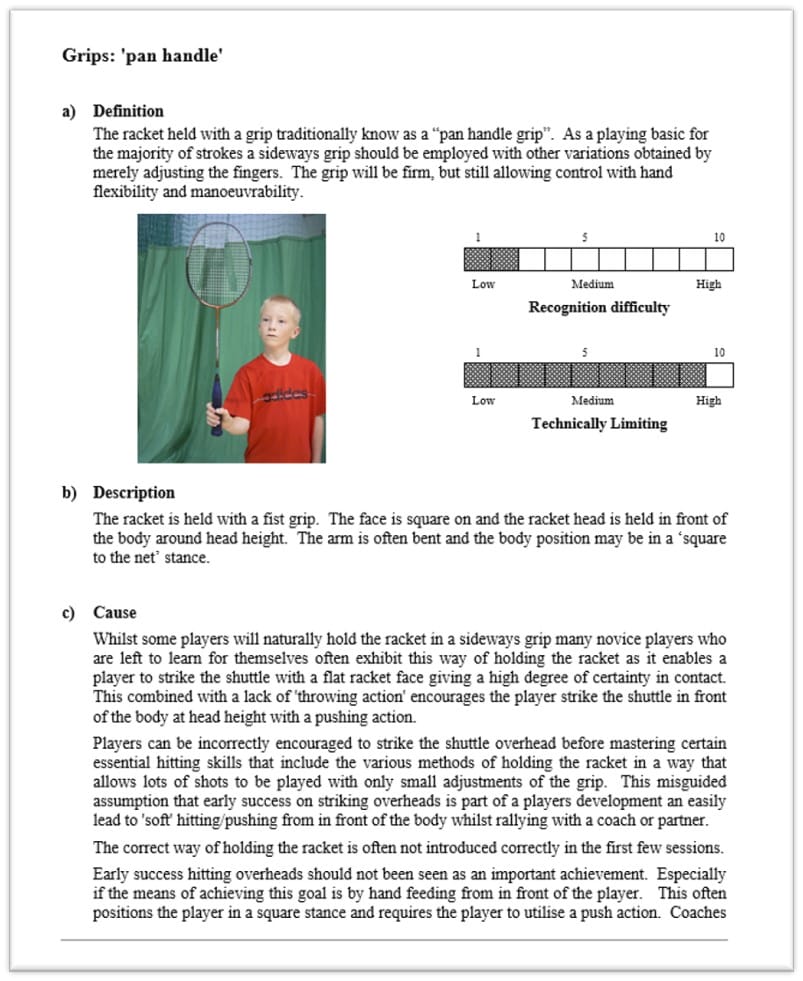 I’ve challenged myself over the next year to create a series of posts each concerned with each one of the critical badminton techniques above.
I’ve challenged myself over the next year to create a series of posts each concerned with each one of the critical badminton techniques above.
The theme of each post will continue to be ‘Error Prevention rather than Error Correction’, however, I will try my best to explore these points:
- what the issue looks like and the different names it’s called
- why I think the issue occurs
- how to correct it
- how to maybe prevent it from ever appearing
I promise to share all the great advice I’ve been given plus the mistakes I’ve made.
Would you like to work with me, share your list and add your ideas and thoughts?
Email me now and we can start talking contact@badmintonandy.com

